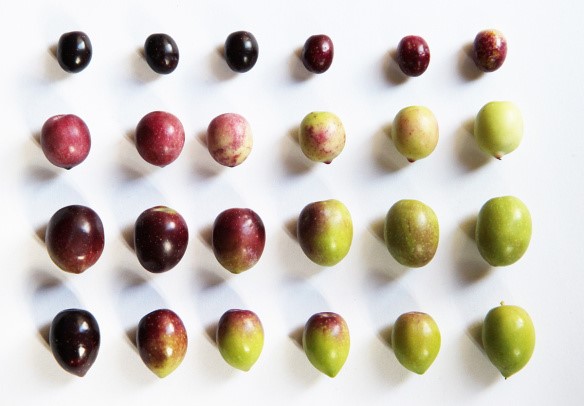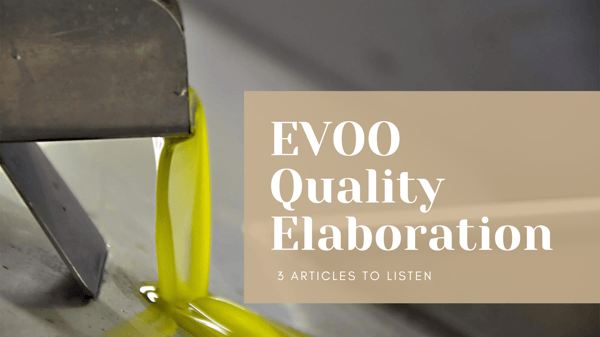Listen to this article
This article tells us the keys to know when to pick the olives to obtain the highest quality in the production of your Extra Virgin Olive Oil (EVOO).
When is the ideal moment to start harvesting the olives?
The ideal time to start planning the harvesting of the olives that we are going to use for the production of an Extra Virgin Olive Oil of the highest quality (Premium Oil, outstanding, high-end or early oils) usually begins at the end of September in the Northern Hemisphere.
We must start selecting those plots that have a medium/high quantity of olives and with a larger fruit size.
Sample
Once we have selected the plots that we want to collect, we will take about 2 kg of olives from each plot located at eye level and in the 4 tree orientations. We homogenize the sample, separate about 100 fruits and classify them in the following categories:
-
- Deep green skin
- Yellowish green skin
- Green skin with some reddish spots.
Color and parameters
Another factor to take into account when marking the optimal time for harvesting is the color that the olive takes. That is, at the moment in which the olive turns from an intense green color to a yellowish green, we resample the plots and send the samples to the laboratory.
Sometimes it is interesting to open the olive because sometimes the color of the pulp is not what we have imagined. It is possible that on the outside we see some parameters that tell us that it is ripe and yet when we open it we see that it is green.
It will be necessary to check the following parameters:
- Fat on dry matter. This parameter must be between 36 and 40%;
- Humidity. Between 58 and 64%;
- Fat performance. It must be between 15 and 18%, but this parameter is not relevant since what we are looking for is quality and not quantity.
Abencor test
When we already have our olives with these parameters, it is the key moment to submit them to the abencor test, in which we simulate the oil extraction process that we would do in the oil mill, but this time it is carried out in a laboratory.
Once we have extracted the oil from the olive samples, it is filtered, tasted and, if the oil has the correct characteristics (fruity, balanced, bitter and pleasant spicy, etc), we will proceed to carry out the harvesting, but always starting for the plots that indicate a higher maturity index.
Why start with the ripest olives?
Because if we start with the less mature ones, as the harvesting lasts approximately 10 days, when we get to harvest the more mature ones, they may already be too ripe to make this type of EVOO.
Another factor to take into account is the weather. You have to be attentive to all weather forecasts to date the optimal time of harvesting. If you have the olives ready, and ¡wait more than necessary, if a storm comes, it will throw part of the olives on the ground and you will lose the harvest. Imagine that we hire a crew, we go out to the field and after half an hour it starts to rain heavily.
Why is the fat yield so variable even on dry matter?
Fat yield, even on dry matter, varies from year to year, on the variety and on the geographical area.
In view of the knowledge of the entire process described above, we explain the factors that influence and make it so difficult to determine for each variety, in each farm, in each locality and in each campaign the Optimum Harvesting Moment for Olives.
- Climatic condition
During the entire lipogenesis process, the climatic condition greatly affects the total or final amount of oil to accumulate, because the natural metabolic process needs a temperature threshold for its correct operation. There are latitudes where, for example, between June and December the two extremes occur, very high temperatures, even many days above 36-38ºC and later, with fruits still green, frosts of up to -4 / -5ºC. Obviously both factors stop lipogenesis for a more or less long period or permanently. - Pruning
With olive tree pruning, the vegetative response of the tree is controlled and production is regulated. This practice allows us to act, with a certain margin, on the size of the fruits, mainly on the pulp / stone ratio. This, together with improved lighting and aeration that pruning entails, allows us to affirm that this cultivation practice favors correct lipogenesis. - Fertilization
Influence of a correct fertilization. The correct use of N (nitrogen) favors a certain delay in maturation that, therefore, would lengthen the lipogenesis process. On the other hand, there is a clear positive correlation between the content of K (potassium) in the fruit and the final amount of oil in it, due to the important role that this element plays in lipogenesis. - Irrigation
In an olive tree well endowed with moisture during the cycle, the fruits are uniform with a high pulp / stone ratio and form the oil in adequate quantity. On the contrary, the lack of moisture in the soil in the stages prior to maturity, causes the existence of small fruits with difficult lipogenesis. - Phytosanitary management
Basically the influence that an adequate pest control can have is to avoid the presence of pests that depress the sprouts, the leaves or the fruits itself, and thereby hinder or interrupt the correct lipogenesis. For the same reason, diseases that directly or indirectly influence fruit development must be avoided. - Variety
Apart from other genetic issues such as sensitivity or resistance to diseases, pests, the ripening time, ease or resistance to abscission, the size of the fruit and its pulp / pit ratio, the variety of the olive has a notorious influence on the quality and final quantity of oil to be obtained.
Here we can see some examples of varieties
Are you ready to obtain full advantage of your olives?
.png)





